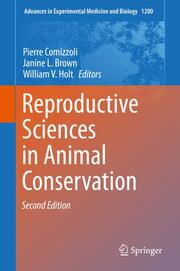Detailansicht
Reproductive Sciences in Animal Conservation
Advances in Experimental Medicine and Biology 1200
ISBN/EAN: 9783030236328
Umbreit-Nr.: 7586711
Sprache:
Englisch
Umfang: viii, 559 S., 12 s/w Illustr., 46 farbige Illustr.
Format in cm:
Einband:
gebundenes Buch
Erschienen am 11.09.2019
Auflage: 2/2019
- Zusatztext
- This second edition emphasizes the environmental impact on reproduction, with updated chapters throughout as well as complete new chapters on species such as sharks and rays. This is a wide-ranging book that will be of relevance to anyone involved in species conservation, and provides critical perspectives on the real utility of current and emerging reproductive sciences.Understanding reproductive biology is centrally important to the way many of the world's conservation problems should be tackled. Currently the extinction problem is huge, with up to 30% of the world's fauna being expected to disappear in the next 50 years. Nevertheless, it has been estimated that the global population of animals in zoos encompasses 12,000 - 15,000 species, and we anticipate that every effort will be made to preserve these species for as long as possible, minimizing inbreeding effects and providing the best welfare standards available. Even if the reproductive biology community cannot solve the global biodiversity crisis for all wild species, we should do our best to maintain important captive populations. Reproductive biology in this context is much more than the development of techniques for helping with too little or too much breeding. While some of the relevant techniques are useful for individual species that society might target for a variety of reasons, whether nationalistic, cultural or practical, technical developments have to be backed up by thorough biological understanding of the background behind the problems.
- Kurztext
- This second edition emphasizes the environmental impact on reproduction, with updated chapters throughout as well as complete new chapters on species such as sharks and rays. This is a wide-ranging book that will be of relevance to anyone involved in species conservation, and provides critical perspectives on the real utility of current and emerging reproductive sciences.Understanding reproductive biology is centrally important to the way many of the world's conservation problems should be tackled. Currently the extinction problem is huge, with up to 30% of the world's fauna being expected to disappear in the next 50 years. Nevertheless, it has been estimated that the global population of animals in zoos encompasses 12,000 - 15,000 species, and we anticipate that every effort will be made to preserve these species for as long as possible, minimizing inbreeding effects and providing the best welfare standards available. Even if the reproductive biology community cannot solve the global biodiversity crisis for all wild species, we should do our best to maintain important captive populations. Reproductive biology in this context is much more than the development of techniques for helping with too little or too much breeding. While some of the relevant techniques are useful for individual species that society might target for a variety of reasons, whether nationalistic, cultural or practical, technical developments have to be backed up by thorough biological understanding of the background behind the problems.
- Autorenportrait
- Pierre Comizzoli, a gamete biologist at SCBI's Center for Species Survival, received one of the Presidential Early Career Award for Scientists and Engineers. President Obama named 94 researchers as recipients of the Presidential Early Career Awards for Scientists and Engineers, the highest honor bestowed by the United States government on science and engineering professionals in the early stages of their independent research careers. Sixteen Federal departments and agencies join together annually to nominate the most meritorious scientists and engineers whose early accomplishments show the greatest promise for assuring America's preeminence in science and engineering and contributing to the awarding agencies' missions. Awardees are selected for their pursuit of innovative research at the frontiers of science and technology and their commitment to community service as demonstrated through scientific leadership, public education, or community outreach. Comizzoli's honor followed a prestigious nomination by the Office of the Director of the National Institutes of Health for studies on desiccated germinal vesicles to determine if they can be rehydrated and reanimated to facilitate recovery of the maternal genome, challenging existing paradigms about the practicality of mammalian oocyte (egg) preservation and storage. Pierre's research is oriented to both assisted reproductive techniques (artificial insemination, embryo transfer, in vitro fertilization, gamete and embryo cryopreservation) for endangered species, as well as the emerging field of fertility preservation that benefits, not only rare species, but human health as well.
